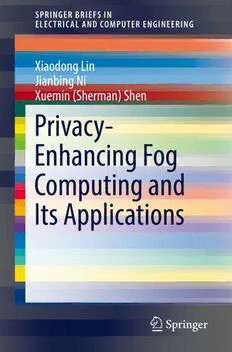Table Of ContentSPRINGER BRIEFS IN
ELECTRICAL AND COMPUTER ENGINEERING
Xiaodong Lin
Jianbing Ni
Xuemin (Sherman) Shen
Privacy-
Enhancing Fog
Computing and
Its Applications
1 23
SpringerBriefs in Electrical and Computer
Engineering
Serieseditors
Woon-SengGan,SchoolofElectricalandElectronicEngineering,Nanyang
TechnologicalUniversity,Singapore,Singapore
C.-C.JayKuo,UniversityofSouthernCalifornia,LosAngeles,CA,USA
ThomasFangZheng,ResearchInstituteofInformationTechnology,Tsinghua
University,Beijing,China
MauroBarni,DepartmentofInformationEngineeringandMathematics,University
ofSiena,Siena,Italy
SpringerBriefs present concise summaries of cutting-edge research and practical
applicationsacrossawidespectrumoffields.Featuringcompactvolumesof50to
125 pages, the series covers a range of content from professional to academic.
Typicaltopicsmightinclude:timelyreportofstate-of-theartanalyticaltechniques,
a bridge between new research results, as published in journal articles, and a
contextualliteraturereview,asnapshotofahotoremergingtopic,anin-depthcase
study or clinical example and a presentation of core concepts that students must
understandinordertomakeindependentcontributions.
Moreinformationaboutthisseriesathttp://www.springer.com/series/10059
Xiaodong Lin • Jianbing Ni
Xuemin (Sherman) Shen
Privacy-Enhancing
Fog Computing
and Its Applications
123
XiaodongLin JianbingNi
DepartmentofPhysicsandComputer ElectricalandComputerEngineering
Science Department
WilfridLaurierUniversity UniversityofWaterloo
Waterloo,ON,Canada Waterloo,ON,Canada
Xuemin(Sherman)Shen
ElectricalandComputerEngineering
Department
UniversityofWaterloo
Waterloo,ON,Canada
ISSN2191-8112 ISSN2191-8120 (electronic)
SpringerBriefsinElectricalandComputerEngineering
ISBN978-3-030-02112-2 ISBN978-3-030-02113-9 (eBook)
https://doi.org/10.1007/978-3-030-02113-9
LibraryofCongressControlNumber:2018959867
©TheAuthor(s),underexclusivelicensetoSpringerNatureSwitzerlandAG2018
Thisworkissubjecttocopyright.AllrightsarereservedbythePublisher,whetherthewholeorpartof
thematerialisconcerned,specificallytherightsoftranslation,reprinting,reuseofillustrations,recitation,
broadcasting,reproductiononmicrofilmsorinanyotherphysicalway,andtransmissionorinformation
storageandretrieval,electronicadaptation,computersoftware,orbysimilarordissimilarmethodology
nowknownorhereafterdeveloped.
Theuseofgeneraldescriptivenames,registerednames,trademarks,servicemarks,etc.inthispublication
doesnotimply,evenintheabsenceofaspecificstatement,thatsuchnamesareexemptfromtherelevant
protectivelawsandregulationsandthereforefreeforgeneraluse.
Thepublisher,theauthorsandtheeditorsaresafetoassumethattheadviceandinformationinthisbook
arebelievedtobetrueandaccurateatthedateofpublication.Neitherthepublishernortheauthorsor
theeditorsgiveawarranty,expressorimplied,withrespecttothematerialcontainedhereinorforany
errorsoromissionsthatmayhavebeenmade.Thepublisherremainsneutralwithregardtojurisdictional
claimsinpublishedmapsandinstitutionalaffiliations.
ThisSpringerimprintispublishedbytheregisteredcompanySpringerNatureSwitzerlandAG
Theregisteredcompanyaddressis:Gewerbestrasse11,6330Cham,Switzerland
Preface
Fog computing has been considered as a key enabler to reach the increasing
demands on local data analysis and numerous device connections for Internet-
of-Things (IoT), by extending computing, storage, and networking resources to
the network edge. Deployed between user devices and cloud centers, fog nodes
monitor or analyze real-time data from network-connected “things,” supporting a
varietyofIoTservices,suchassmarttrafficlights,homeenergymanagement,and
augmented reality. As a promising extension of cloud computing, fog computing
canofferon-demandandubiquitousapplicationsonnearbydevicesthatcanresult
in superior user experience and increase redundancy in case of failures. Despite
the appealing advantages, fog computing is confronted with various security and
privacythreatsduetoubiquitousconnectionsandlimitedresources,whichhavenot
beensystemicallydiscussedintheliterature.
In this monograph, we address the security and privacy challenges in fog
computing and propose secure and privacy-preserving schemes to deal with these
challenges for securing fog-assisted IoT applications. The research is of great
importance since security and privacy problems faced by fog computing impede
the healthy development of its enabled IoT applications. In Chap.1, we introduce
the architecture of fog-assisted IoT applications and the security and privacy
challenges in fog computing. In Chap.2, we review several promising privacy-
enhancing techniques and show examples on how to leverage these techniques to
enhancetheprivacyofusersinfogcomputing.Specifically,wedividetheexisting
privacy-enhancing techniques into three categories: identity privacy-enhancing
techniques, location privacy-enhancing techniques, and data privacy-enhancing
techniques. With the advanced privacy-enhancing techniques, we propose three
secure and privacy-preserving schemes for fog computing applications, including
smart parking navigation, mobile crowdsensing, and smart grid, which will be
detailed in the next three chapters. In Chap.3, we introduce the identity privacy
leakageinsmartparkingnavigationsystemsandproposeaprivacy-preservingsmart
parkingnavigationschemetopreventidentityprivacyexposureandsupportefficient
parking guidance retrieval through road-side units (fogs) with high retrieving
v
vi Preface
probability and security guarantees. In Chap.4, we introduce the location privacy
leakageduringtaskallocationinmobilecrowdsensingandproposeastrongprivacy-
preservingtaskallocationschemethatenableslocation-basedtaskallocationbased
on fog computing without exposing knowledge about the location of participators
inmobilecrowdsensing.InChap.5,weintroducethedataprivacyleakageinsmart
grid and propose an efficient and privacy-preserving smart metering scheme to
allow collectors (fogs) to achieve real-time measurement collection with privacy-
enhanced data aggregation, even if the collectors are compromised or curious
about collected data. Finally, remarks and future research directions are given in
Chap.6. This monograph validates the significant feature extension and efficiency
improvement of IoT devices without sacrificing the security and privacy of users
against dishonest fog nodes. It also provides valuable insights on the security and
privacyprotectionforfog-enabledIoTapplications.
WewouldliketothankProf.KuanZhangattheUniversityofNebraska-Lincoln
and Prof. Yong Yu at Shaanxi Normal University for their contributions in the
presentedresearchworks.WewouldalsoliketothankDongxiaoLiu,ChengHuang,
MengLi,andLiangXueforreviewingpartsofthismonograph,andallthemembers
ofbroadbandcommunicationresearchgroupforthevaluablediscussionsandtheir
insightful suggestions and comments. Special thanks are also due to the staff at
Springer Science+Business Media, especially Susan Lagerstrom-Fife for her help
throughoutthepublicationpreparationprocess.
Waterloo,Canada XiaodongLin
JianbingNi
Xuemin(Sherman)Shen
Contents
1 Introduction ................................................................... 1
1.1 FogComputing........................................................... 1
1.2 Fog-EnabledIoT......................................................... 2
1.2.1 ArchitectureofFog-EnabledIoT ............................... 2
1.2.2 ApplicationsofFog-EnabledIoT............................... 4
1.3 SecurityandPrivacyChallenges ........................................ 5
1.4 AimoftheMonograph................................................... 6
References...................................................................... 7
2 Privacy-EnhancingTechnologies............................................ 9
2.1 IdentityPrivacy-EnhancingTechniques ................................ 9
2.1.1 Pseudonymization ............................................... 9
2.1.2 k-Anonymity..................................................... 10
2.1.3 Mix-Network..................................................... 12
2.1.4 BlindSignature .................................................. 14
2.1.5 GroupSignature ................................................. 16
2.1.6 RingSignature................................................... 19
2.2 LocationPrivacy-EnhancingTechniques ............................... 21
2.2.1 Obfuscation ...................................................... 21
2.2.2 DifferentialLocationPrivacy ................................... 22
2.2.3 Privacy-PreservingLocationMatching......................... 24
2.3 DataPrivacy-EnhancingTechniques.................................... 25
2.3.1 Randomization................................................... 25
2.3.2 DataEncryption.................................................. 26
2.3.3 DifferentialPrivacy.............................................. 27
2.3.4 Zero-KnowledgeProof.......................................... 28
2.4 Summary ................................................................. 31
References...................................................................... 31
vii
viii Contents
3 IdentityPrivacyProtectioninSmartParkingNavigation ............... 35
3.1 ProblemStatement....................................................... 37
3.1.1 SystemModel.................................................... 37
3.1.2 SecurityThreats.................................................. 39
3.1.3 SecurityGoals ................................................... 39
3.2 P-SPAN................................................................... 40
3.2.1 OverviewofP-SPAN............................................ 40
3.2.2 TheDetailedP-SPAN ........................................... 40
3.3 SecurityDiscussion...................................................... 46
3.4 RetrievingProbabilityandPerformanceAnalysis...................... 48
3.4.1 RetrievingProbability ........................................... 48
3.4.2 ComputationalOverhead........................................ 49
3.4.3 CommunicationOverhead....................................... 50
3.5 Summary ................................................................. 51
References...................................................................... 52
4 LocationPrivacyProtectioninMobileCrowdsensing.................... 55
4.1 ProblemStatement....................................................... 57
4.1.1 SystemModel.................................................... 57
4.1.2 ThreatModel..................................................... 58
4.1.3 DesignGoals..................................................... 58
4.2 PPFMC ................................................................... 59
4.3 SecurityDiscussion...................................................... 61
4.4 PerformanceEvaluation ................................................. 62
4.4.1 ComputationalOverhead........................................ 63
4.4.2 CommunicationOverhead....................................... 63
4.5 Summary ................................................................. 65
References...................................................................... 65
5 DataPrivacyProtectioninSmartGrid..................................... 67
5.1 ProblemStatement....................................................... 69
5.1.1 SystemModel.................................................... 69
5.1.2 SecurityModel................................................... 70
5.1.3 DesignGoals..................................................... 71
5.2 P2SM ..................................................................... 72
5.2.1 OverviewofP2SM............................................... 72
5.2.2 TheDetailedP2SM.............................................. 73
5.3 SecurityAnalysis......................................................... 77
5.4 PerformanceEvaluation ................................................. 81
5.4.1 ComputationalCost.............................................. 81
5.4.2 CommunicationandStorageOverhead......................... 83
5.5 Summary ................................................................. 84
References...................................................................... 84
Contents ix
6 SummaryandFutureDirections............................................ 87
6.1 Summary ................................................................. 87
6.2 FutureResearchDirections.............................................. 88
6.2.1 DetectionofRogueFogsandDevices.......................... 88
6.2.2 PrivacyExposureinDataCombination ........................ 89
6.2.3 DecentralizedandScalableSecureInfrastructure.............. 89

